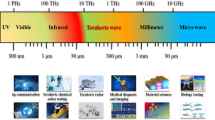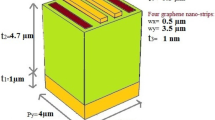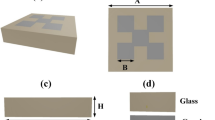Abstract
A theoretical investigation and simulation of a terahertz metasurface refractive index sensor composed of graphene-metal is presented in this article. The analysis and evaluation of the reflector’s performance are conducted through the implementation of the frequency-domain finite-difference method. The transmission and reflection spectra are analyzed in order to identify the characteristic dimensions that can enhance both sensitivity and reflectivity by optimizing the material’s thickness, cycle duration, and width of the etching structure. The findings indicate that the sensor exhibits a quality factor of 8.4 and a maximal refractive index sensitivity of 1.48 THz/RIU within the operating frequency range of 0.1–2.0 THz. These values are three times greater than those of the conventional sensor. The design of this refractive index sensor has the potential to revolutionize bioassays pertaining to the quantification of proteins, viruses, cancer cells, and their markers.











Similar content being viewed by others
Data Availability
The datasets generated during and/or analyzed during the current study are not publicly available due to [The model data of the paper research are presented in this paper] but are available from the corresponding author on reasonable request.
References
Watts CM, Liu X, Padilla WJ (2012) Metamaterial electromagnetic wave absorbers. Advanced materials 24(23):OP98–OP120. https://doi.org/10.1002/adma.201200674
Landy NI, Sajuyigbe S, Mock JJ, Smith DR, Padilla WJ (2008) Perfect metamaterial absorber. Phys Rev Lett 100(20):207402. https://doi.org/10.1103/PhysRevLett.100.207402
Yang D, Zhang C, Ju X, Ji Y, Lan C (2020) Multi-resonance and ultra-wideband terahertz metasurface absorber based on micro-template-assisted self-assembly method. Opt Express 28(2):2547–2556. https://doi.org/10.1364/OE.381927
Suen JY, Fan K, Padilla WJ, Liu X (2017) All-dielectric metasurface absorbers for uncooled terahertz imaging[J]. Optica 4(6):601–604. https://doi.org/10.1364/OPTICA.4.000601
Iwaszczuk K, Strikwerda AC, Fan K, Zhang X, Averitt RD, Jepsen PU (2012) Flexible metamaterial absorbers for stealth applications at terahertz frequencies. Opt Express 20(1):635–643. https://doi.org/10.1364/OE.20.000635
Wang BX, Wang GZ, Wang LL (2016) Design of a novel dual-band terahertz metamaterial absorber. Plasmonics 11:523–530. https://doi.org/10.1007/s11468-015-0076-2
Wang BX (2016) Quad-band terahertz metamaterial absorber based on the combining of the dipole and quadrupole resonances of two SRRs. IEEE J Sel Top Quantum Electron 23(4):1–7. https://doi.org/10.1109/JSTQE.2016.2547325
Cui Z, Wang Y, Shi Y, Zhu Y, Zhang D, Hong Z, Feng X (2022) Significant sensing performance of an all-silicon terahertz metasurface chip for Bacillus thuringiensis Cry1Ac protein. Photonics Research 10(3):740–746. https://doi.org/10.1364/PRJ.450017
Wang BX, Tang C, Niu Q et al (2019) Design of narrow discrete distances of dual-/triple-band terahertz metamaterial absorbers. Nanoscale Res Lett 14:64. https://doi.org/10.1186/s11671-019-2876-3
Li J, Chen X, Yi Z, Yang H, Tang Y, Yi Y, Yi Y (2020) Broadband solar energy absorber based on monolayer molybdenum disulfide using tungsten elliptical arrays. Mater. Today Energy 16. https://doi.org/10.1016/j.mtener.2020.100390
You X, Ako RT, Lee WS, Bhaskaran M, Sriram S, Fumeaux C, Withayachumnankul W (2021) Terahertz transmissive half-wave metasurface with enhanced bandwidth. Opt Lett 46(17):4164–4167. https://doi.org/10.1364/OL.431285
Yu N, Aieta F, Genevet P, Kats MA, Gaburro Z, Capasso F (2012) A broadband, background-free quarter-wave plate based on plasmonic metasurfaces. Nano Lett 12(12):6328–6333. https://doi.org/10.1021/nl303445u
Fugallo G, Cepellotti A, Paulatto L, Lazzeri M, Marzari N, Mauri F (2014) Thermal conductivity of graphene and graphite: collective excitations and mean free paths. Nano Lett 14(11):6109–6114. https://doi.org/10.1021/nl502059f
Sang M, Shin J, Kim K, Yu KJ (2019) Electronic and thermal properties of graphene and recent advances in graphene based electronics applications. Nanomaterials 9(3):374. https://doi.org/10.3390/nano9030374
Nasirifar R, Danaie M, Dideban A (2022) Highly sensitive surface plasmon resonance sensor using perforated optical fiber for biomedical applications. Optik 250:168051. https://doi.org/10.1016/j.ijleo.2021.168051
Wang BX, Wang GZ, Wang LL, Zhai X (2015) Design of a five-band terahertz absorber based on three nested split-ring resonators. IEEE Photonics Technol Lett 28(3):307–310. https://doi.org/10.1109/LPT.2015.2495245
Wu L, Wang Y, Li H, Wang Z, Ge M, Xu D, Yao J (2022) Optimization for continuous-wave terahertz reflection imaging for biological tissues. J Biophotonics 15(1):e202100245. https://doi.org/10.1002/jbio.202100245
Zou Y, Zhong M, Li S, Qing Z, Xing X, Gong G, Yan R, Qin W, Shen J, Zhang H (2023) Flexible wearable strain sensors based on laser-induced graphene for monitoring human physiological signals. Polymers 15(17):3553. https://doi.org/10.3390/polym15173553
Zhong M, Li S, Zou Y, Fan H, Jiang Y, Qiu C, Yang L (2024) Hydrophobic surface array structure based on laser-induced graphene for deicing and anti-icing applications. Micromachines 15(2):285. https://doi.org/10.3390/mi15020285
Esfandiyari M, Lalbakhsh A, Jarchi S, Ghaffari-Miab M, Mahtaj HN, Simorangkir RB (2022) Tunable terahertz filter/antenna-sensor using graphene-based metamaterials. Mater Des 220:110855. https://doi.org/10.1016/j.matdes.2022.110855
Esfandiyari M, Norouzi M, Haghdoust P et al (2018) Study of a surface plasmon resonance optical fiber sensor based on periodically grating and graphene. SILICON 10:2711–2716. https://doi.org/10.1007/s12633-018-9810-7
Esfandiyari M, Jarchi S, Ghaffari-Miab M (2019) Channel capacity enhancement by adjustable graphene-based MIMO antenna in THz band. Opt Quant Electron 51:137. https://doi.org/10.1007/s11082-019-1856-2
Hou X, Zhang L, Su Y, Gao G, Liu Y, Na Z, Chen T (2023) A space crawling robotic bio-paw (SCRBP) enabled by triboelectric sensors for surface identification. Nano Energy 105.https://doi.org/10.1016/j.nanoen.2022.108013
Esfandiari M, Lalbakhsh A, Shehni PN, Jarchi S, Ghaffari-Miab M, Mahtaj HN et al (2022) Recent and emerging applications of Graphene-based metamaterials in electromagnetics. Mater Des 221:110920. https://doi.org/10.1016/j.matdes.2022.110920
Tan TC, Srivastava YK, Ako RT, Wang W, Bhaskaran M, Sriram S et al (2021) Active control of nanodielectric-induced THz quasi-BIC in flexible metasurfaces: a platform for modulation and sensing. Adv Mater 33(27):2100836. https://doi.org/10.1002/adma.202100836
Cui N, Guan M, Xu M, Fang W, Zhang Y, Zhao C, Zeng Y (2020) Design and application of terahertz metamaterial sensor based on DSRRs in clinical quantitative detection of carcinoembryonic antigen. Opt Express 28(11):16834–16844. https://doi.org/10.1364/OE.393397
Nickpay MR, Danaie M, Shahzadi A (2021) Highly sensitive THz refractive index sensor based on folded split-ring metamaterial graphene resonators. Plasmonics 1–12. https://doi.org/10.1007/s11468-021-01512-8
Esfandiari M, Jarchi S, Nasiri-Shehni P, Ghaffari-Miab M (2021) Enhancing the sensitivity of a transmissive graphene-based plasmonic biosensor. Appl Opt 60(5):1201–1208. https://doi.org/10.1364/AO.411974
Al-Naib I (2021) Sensing glucose concentration using symmetric metasurfaces under oblique incident terahertz waves. Crystals 11(12):1578. https://doi.org/10.3390/cryst11121578
Geng Z, Zhang X, Fan Z et al (2017) A route to terahertz metamaterial biosensor integrated with microfluidics for liver cancer biomarker testing in early stage. Sci Rep 7:16378. https://doi.org/10.1038/s41598-017-16762-y
Gao JY, Liu J, Yang HM, Liu HS, Zeng G, Huang B (2023) Anisotropic medium sensing controlled by bound states in the continuum in polarization-independent metasurfaces. Opt Express 31(26):44703–44719. https://doi.org/10.1364/OE.509673
Yao H, Mei H, Zhang W, Zhong S, Wang X (2021) Theoretical and experimental research on terahertz metamaterial sensor with flexible substrate. IEEE Photonics J 14(1):1–9. https://doi.org/10.1109/JPHOT.2021.3124414
Wang J, Yang L, Hu ZD, He W, Zheng G (2019) Analysis of graphene-based multilayer comb-like absorption system based on multiple waveguide theory. IEEE Photonics Technology Letters 31(7):561–564. https://doi.org/10.1109/LPT.2019.2902437
Hanson GW (2008) Dyadic Green’s functions and guided surface waves for a surface conductivity model of graphene. Journal of Applied Physics 103(6). https://doi.org/10.1063/1.2891452
Falkovsky LA, Pershoguba SS (2007) Optical far-infrared properties of a graphene monolayer and multilayer. Phys Rev B 76(15):153410. https://doi.org/10.1103/PhysRevB.76.153410
Nickpay MR, Danaie M, Shahzadi A (2022) Design of a graphene-based multi-band metamaterial perfect absorber in THz frequency region for refractive index sensing. Physica E 138:115114. https://doi.org/10.1103/PhysRevB.76.153410
Thareja V, Kang JH, Yuan H, Milaninia KM, Hwang HY, Cui Y, Brongersma ML (2015) Electrically tunable coherent optical absorption in graphene with ion gel. Nano letters 15(3):1570–1576. https://doi.org/10.1021/nl503431d
Zhan F, Lin YS (2020) Tunable multiresonance using complementary circular metamaterial. Opt Lett 45(13):3633–3636. https://doi.org/10.1364/OL.394137
Hou X, Chen X, Li T, Li Y, Tian Z, Wang M (2021) Highly sensitive terahertz metamaterial biosensor for bovine serum albumin (BSA) detection. Optical Materials Express 11(7):2268–2277. https://doi.org/10.1364/OME.431339
Ye D, Wang Z, Xu K, Li H, Huangfu J, Wang Z, Ran L (2013) Ultrawideband dispersion control of a metamaterial surface for perfectly-matched-layer-like absorption. Phys Rev Lett 111(18):187402. https://doi.org/10.1103/PhysRevLett.111.187402
Author information
Authors and Affiliations
Contributions
LC and WQ designed the study, performed the research, analyzed data, and wrote the paper.
Corresponding author
Ethics declarations
Competing Interest
The authors declare no competing interests.
Additional information
Publisher's Note
Springer Nature remains neutral with regard to jurisdictional claims in published maps and institutional affiliations.
Rights and permissions
Springer Nature or its licensor (e.g. a society or other partner) holds exclusive rights to this article under a publishing agreement with the author(s) or other rightsholder(s); author self-archiving of the accepted manuscript version of this article is solely governed by the terms of such publishing agreement and applicable law.
About this article
Cite this article
Li, C., Wu, Q. Graphene-Based Tunable High-Sensitivity Metasurface Refractive Index Sensor. Plasmonics (2024). https://doi.org/10.1007/s11468-024-02283-8
Received:
Accepted:
Published:
DOI: https://doi.org/10.1007/s11468-024-02283-8




